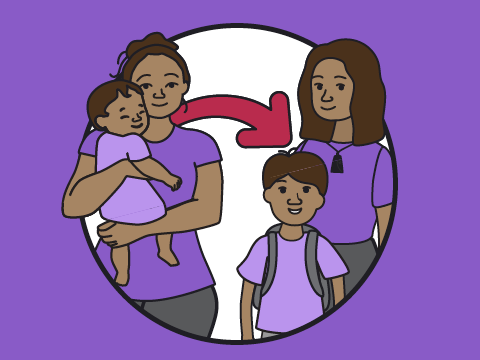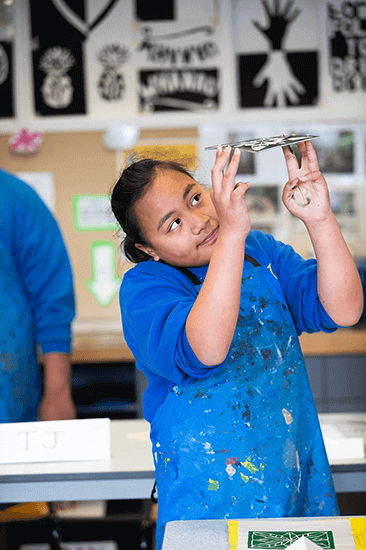Inclusive practice: Early years to primary | Te whare kōhungahunga ki te kura
Moving from early years education to primary school is a big step for all ākonga. How we set up our learning spaces will help create a sense of belonging and wellbeing that is conducive to meeting learning needs and building on learner strengths.
On this page:
On this page:
Current page section: Inclusive practice: Early years to primary | Te whare kōhungahunga ki te kura
Go to top of current page: Inclusive practice: Early years to primary | Te whare kōhungahunga ki te kura
Go to top of current page: Inclusive practice: Early years to primary | Te whare kōhungahunga ki te kura
Go to top of current page: Inclusive practice: Early years to primary | Te whare kōhungahunga ki te kura
"Te piko o te māhuri, tērā te tupu o te rākau"
The way in which the young sapling is nurtured, determines how the tree will grow.
Why this matters | Te take
Why this matters | Te take
A well-organised and sensory-friendly classroom helps create a positive and supportive atmosphere that fosters independence, comfort, and confidence.

Source: Ministry of Education | Te Tāhuhu o te Mātauranga
Sensory supports | Ngā taituarā tairongo
Sensory supports | Ngā taituarā tairongo
Many students find school environments and teaching methods challenging. We can set ākonga up for success by creating sensory-friendly spaces and choosing pedagogical practices that increase focus and engagement.
Source: ADHDvoices
Closed Captions
Routines and breaks | Ngā mahi me ngā wā whakatā
Routines and breaks | Ngā mahi me ngā wā whakatā
Consider how you will set up routines:
- Create small, achievable tasks that appeal to sensory interests.
- Use your observation data from the previous setting to make the transition into the new space as smooth as possible.
- Offering regular break times that appeal to ākonga learning needs is crucial.
- Notice which parts of the day and learning experiences are more challenging and plan ahead for break times. Identify which areas of the curriculum are ākonga strengths.
- Be flexible in your daily routines. There is a lot of adjustment for ākonga.
- Keep the vision of whānau in mind when setting up routines and daily learning programmes.
Plan, teach and assess collaboratively | Te whakamahere me te aromatawai
Plan, teach and assess collaboratively | Te whakamahere me te aromatawai
- Meet regularly across the wider team – encourage your teaching team to plan a curriculum that is inclusive of ākonga strengths and is informed by whānau identity and vision, school resources, and social groups.
- Provide flexibility with assessment – some assessments may require extra teacher release time. Some assessments may be used that are different from mainstream methods. Apply tools that use what you know about your learner and allow them to “show what they know”.
- Integrate choice – the best learning offers choice within every aspect of a learning programme.
- Integrate and use relationships – provide opportunities for peers to be involved in the learning experience.
- Consider sensory needs – these may include: breakout or quiet spaces, wait time (up to 5 minutes), teacher talk vs. activities, visual tools, interactive digital communication tools, music and movement, games and play equipment.
- Use shared digital tools – digital platforms help keep track of goals, progress, and communication.
Possibilities in new roles | Ngā āheitanga
Possibilities in new roles | Ngā āheitanga
By creating roles that are mana-enhancing and foster dignity, respect, and inclusion, ākonga learn to develop self-worth and purpose by using their strengths within their school community.
Identify potential roles they could be interested in developing by noticing what aligns most with their interests and strengths.
"E koekoe te tūī, e ketekete te kākā, e kūkū te kererū"
The tūī chatters, the kākā cackles, the kererū coos.
Embrace diversity, everyone deserves respect and inclusion.

Source: Ministry of Education | Te Tāhuhu o te Mātauranga
Useful resources | He rauemi
Useful resources | He rauemi

Collaborative planning guide
This Inclusive Education guide provides strategies and guidance for planning together as a team, inclusive of whānau and their aspirations for their child.
Next steps
More suggestions for implementing the strategy “Prepare your environment | Te whakarite wāhi ako”:
-
Create an accessible learning environment | Te waihanga wāhi ako tomopai
-
Current page Inclusive practice: Early years to primary | Te whare kōhungahunga ki te kura
-
Inclusive practice: Primary to secondary | Kura tuatahi ki te kura tuarua
Return to the guide “Te Ara Ako – Learning pathways in times of change”
How to use this site
Guide to Index of the guide: Te Ara Ako – Learning pathways in times of change
Understand:
Strategies for action:
-
Nurture whānau partnerships | WhanaungatangaShow suggestions for Nurture whānau partnerships | Whanaungatanga
-
Develop ākonga partnerships | Te mahi tahi me ngā ākongaShow suggestions for Develop ākonga partnerships | Te mahi tahi me ngā ākonga
-
Prepare your environment | Te whakarite wāhi akoShow suggestions for Prepare your environment | Te whakarite wāhi ako
- Create an accessible learning environment | Te waihanga wāhi ako tomopai
- Inclusive practice: Early years to primary | Te whare kōhungahunga ki te kura
- Inclusive practice: Primary to secondary | Kura tuatahi ki te kura tuarua
-
Working as a team | He whānau kotahi tātouShow suggestions for Working as a team | He whānau kotahi tātou

